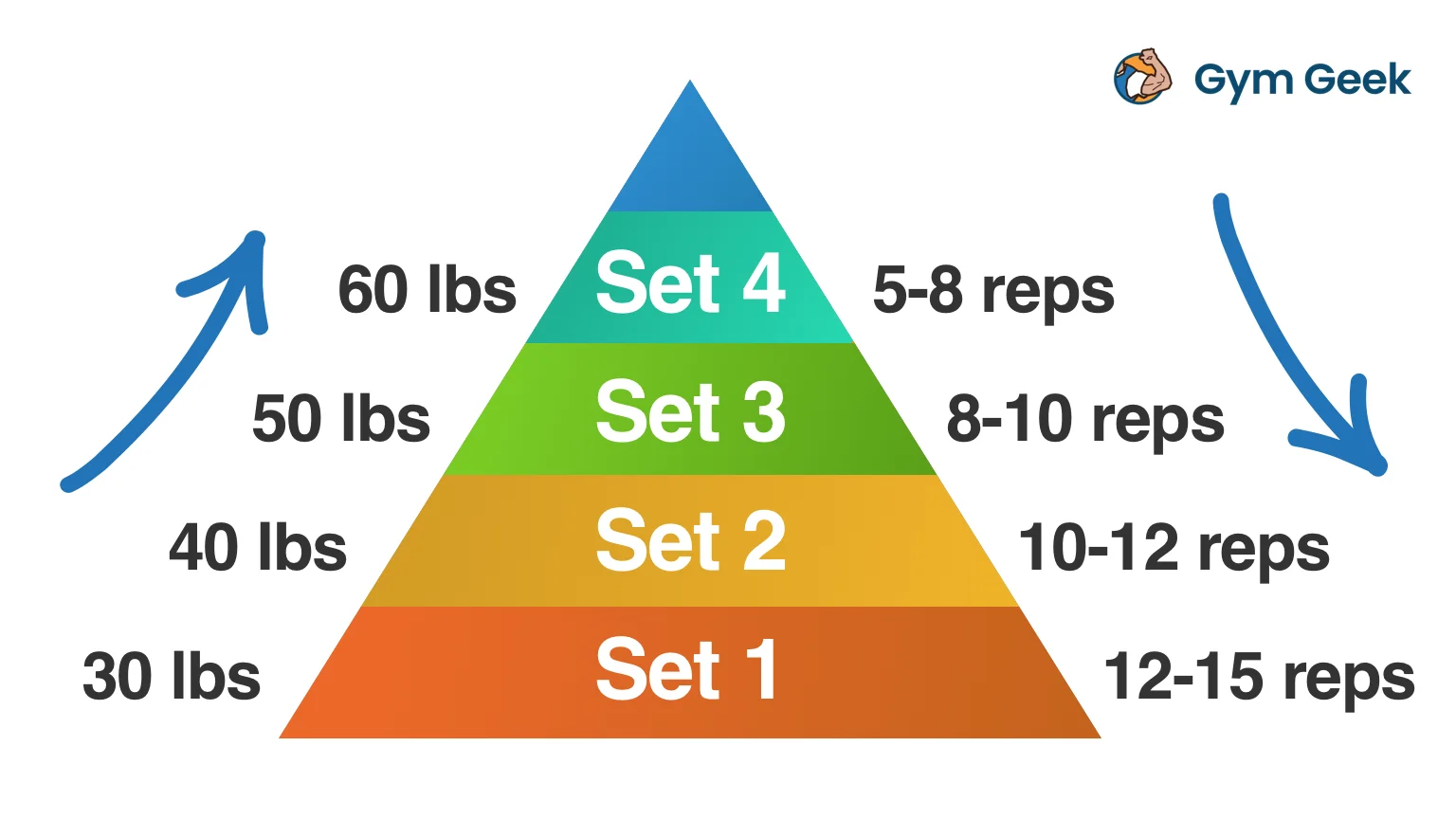
The origins of the 6 day Arnold split can be traced back to Arnold Schwarzenegger himself. Arnold followed intense training programs through his period as 7-time Mr Olympia champion, with the Arnold split emphasizing high frequency and high volume training.
Bodybuilders use this classic workout routine for muscle growth and hypertrophy because of its high frequency of training for each muscle group.
The style of the Arnold split is to follow three different workouts, each twice per week. Each day focuses on a different group of muscles – either chest and back, shoulders and arms or just legs. Arnold famously trained twice per day, which very few people will be able to follow!
There is no definitive ‘Arnold split’, so this is our take on it.
Arnold split vs PPL
Push pull legs (PPL) is the go-to 6 day bodybuilding routine for most. PPL divides workouts based on the type of movement – push exercises (e.g. bench press), pull exercises (e.g. rows) and leg exercises.
PPL, like the Arnold split, provides a high frequency and volume. But the Arnold program is overall much more rigorous. The Arnold split also does a better job as spreading the intensity across the body’s different muscle groups, which can lead to more symmetrical muscle development.
The 6 day Arnold split targets your muscle groups in three different workouts: chest and back, shoulders and arms and, finally, legs and lower back. It’s highly intensive, mostly made up of compound exercises and involving lots of sets and supersets.
Structure of the Arnold split
The 6 day Arnold split is a high volume bodybuilding program designed to increase muscle mass. The routine is structured to target each major muscle group twice each week. Each workout session focuses on heavy compound bodybuilding movements, followed by isolation exercises for specific muscle groups.
A typical week following the Arnold split will look like this:
- Day 1 and Day 4 – Chest and Back. These workouts focus on heavy compound movements like the bench press, deadlifts and rows. They are followed by isolation exercises like dumbbell flyes for your chest and lat pulldowns for your back.
- Day 2 and Day 5 – Shoulders and Arms. Here you’ll be doing overhead presses and lateral raises for your shoulders, before moving onto bicep curls and tricep extensions for your arms.
- Day 3 and Day 6 – Legs and Lower Back. These days start with squats or leg presses, followed by lunges, leg curls and calf raises. Deadlifts or hyperextensions can be included for your lower back.
- Day 7 – Rest day
Because the Arnold split sees you work each muscle group twice per week, the routine maximizes your frequency (the number of times you work a muscle group over the week) and enables you to achieve a higher training volume in your routine.
High training volumes are crucial to stimulating muscle growth and increasing your total muscle mass. If your goal is muscle hypertrophy, then using a workout routine like the Arnold split to achieve a high volume can be a good approach to training.
If volume is the key to hypertrophy, it makes sense to hit your muscles with as much frequency as possible. The major limitation here is the amount of rest time you need to allow between workouts. Muscle repair is what causes your muscles to grow stronger and bigger, and this process takes up to 48 hours after working out.
Because of the way the Arnold split separates muscle groups, it provides the minimum 48 hour recovery period needed before you work the same muscle group again.
Example Arnold split workout
Day 1 and 4 – Chest and Back
- Flat barbell bench press – 3-4 sets of 8-10 reps
- Incline barbell bench press – 3-4 sets of 8-10 reps
- Pullovers – 3-4 sets of 8-10 reps
- Deadlifts – 3 sets of 8-10 reps
- Weighted chin-ups – 3-4 sets of 8-10 reps
- Bent over rows – 4 sets of 8-10 reps
Day 2 and 5 – Shoulders and Arms
- Overhead press – 3-4 sets of 8-10 reps
- Dumbbell front raises – 3-4 sets of 8-10 reps
- Dumbbell lateral raises – 3-4 sets of 8-10 reps
- Dumbbell rear delt flyes – 3-4 sets of 8-10 reps
- Arnold press – 3-4 sets of 8-10 reps
- Standing dumbbell curls – 4 sets of 8-12 reps
- Concentration curls – 4 sets of 8-12 reps
- Reverse curls – 3-4 sets of 8-12 reps
- Barbell tricep extensions – 4-5 sets of 8-12 reps
- Lying french presses (Skull crushers) – 3-4 sets of 8-10 reps
Day 3 and 6 – Legs and Lower Back
- Squats – 3-4 sets of 8-10 reps
- Front squats – 3-4 sets of 8-10 reps
- Hack squats – 3-4 sets of 8-10 reps
- Lunges – 3-4 sets of 8-10 reps
- Leg curls – 3-4 sets of 8-10 reps
- Deadlift – 3-4 sets of 8-10 reps
- Raised step calf raises – 3 sets of 8-10 reps
- Seated calf raises – 2 sets of 8-10 reps
Day 7 – Rest

Variations
Pyramid sets
Pyramid sets is a method of training where, during an exercise, you progressively increase the weight being lifted while decreasing the number of reps performed in each set. You start with a lighter weight at a higher number of reps. As you go through each set, the weight becomes heavier and the reps reduces.
The initial sets naturally serve as warm-up sets, preparing your muscles for the heavier weights. By the end of the exercise, your muscles are primed for the heavier lifts.

You can use pyramid sets with the Arnold split, but your workout will look a little different. For example, taking an exercise in the above workout split that recommends “3-4 sets of 8-10 reps”, you could adjust it in this way with pyramid sets:
- Set 1 – 30 lbs of weight with 12-15 reps
- Set 2 – 40 lbs of weight with 10-12 reps
- Set 3 – 50 lbs of weight with 8-10 reps
- Set 4 – 60 lbs of weight with 5-8 reps
The weights here are just given as examples, but you will need to establish the best way of increasing weight that is appropriate for you. The exact weights and reps will vary based on your fitness level and goals.
Supersets
Supersets is where you pair two exercises together with no rest in between. The exercises can be chosen to work the same muscle group or they can target different muscle groups (depending on the desired training effect).
You begin with the first exercise, completing reps in the first set. Then, you immediately move onto the first set of the second exercise without resting. After completing the second exercise, that’s one full superset. You might rest for 30-90 seconds before repeating the superset.
Arnold was a big fan of supersets, as it’s an effective way to use your time in the gym. You’ll find many opportunities for superset in the Arnold split. For example, you could superset Incline Dumbbell Press & Bent Over Rows on your Chest and Back day.
References
Schoenfeld, B. J., Ogborn, D., & Krieger, J. W. (2017). Dose-response relationship between weekly resistance training volume and increases in muscle mass: A systematic review and meta-analysis. Journal of sports sciences, 35(11), 1073-1082.
MacDougall, J. D., Gibala, M. J., Tarnopolsky, M. A., MacDonald, J. R., Interisano, S. A., & Yarasheski, K. E. (1995). The time course for elevated muscle protein synthesis following heavy resistance exercise. Canadian Journal of applied physiology, 20(4), 480-486.
ENDS
